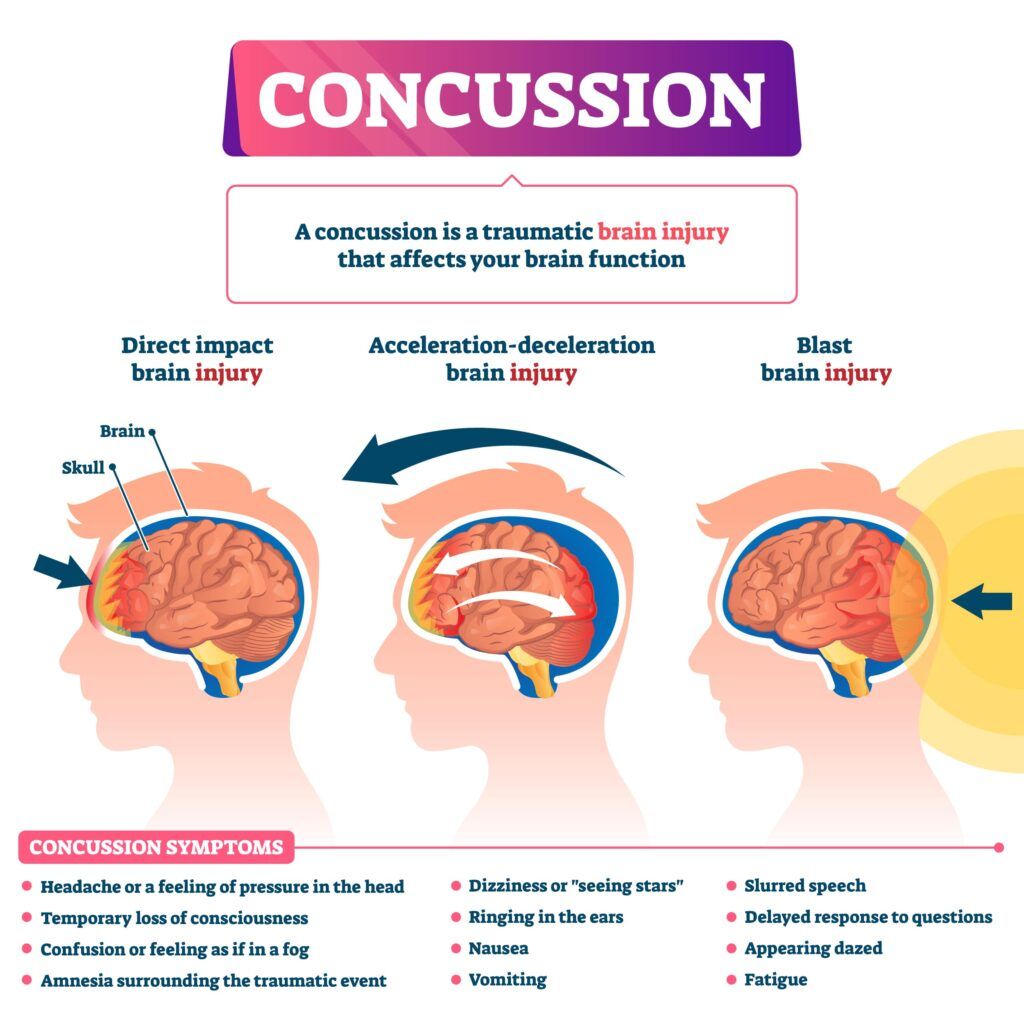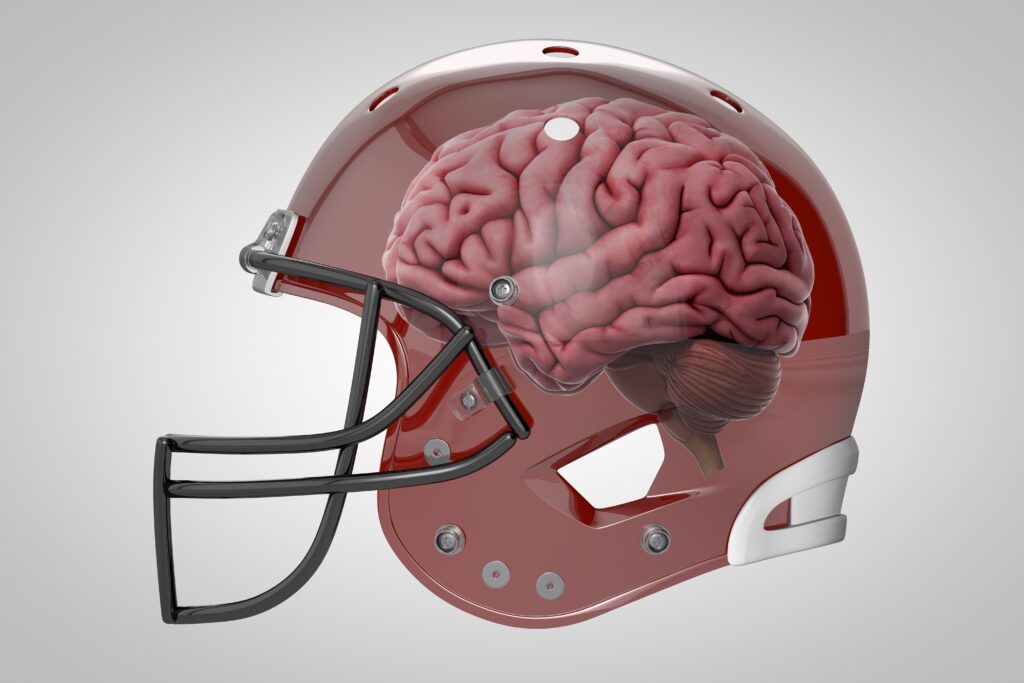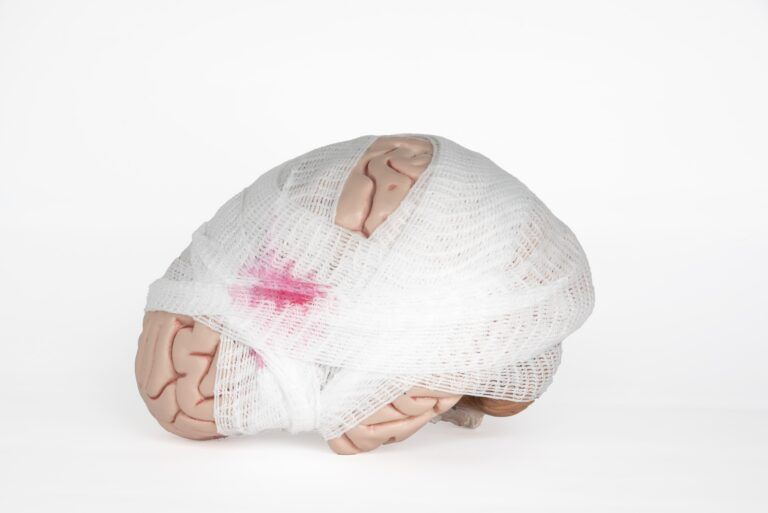Concussions are a critical concern in the world of sports, posing significant risks to the health and performance of athletes. Defined as a type of traumatic brain injury caused by a bump, blow, or jolt to the head, concussions can lead to various short and long-term health issues. The management and prevention of these injuries are paramount in the sports community, given the high incidence rates across both contact and non-contact disciplines. This blog aims to shed light on the nature of concussions, their prevalence in the athletic world, and the best practices for their prevention and management. By understanding the intricacies of concussions, the sports community can better safeguard athletes, ensuring their well-being and sustaining their careers in the long term.
In This Blog:
- Understanding Concussions
- Incidence of Concussions in Sports
- Prevention Strategies
- Concussion Management
Understanding Concussions
Concussions are often described as mild traumatic brain injuries, but there is nothing mild about their potential impact on the brain. They occur when a forceful blow or jolt to the head or body causes the brain to move rapidly back and forth inside the skull. This sudden movement can lead to a temporary disruption in brain function, affecting neurological processes.

The symptoms of a concussion can vary widely and may not be immediately apparent. They often include headaches, dizziness, confusion, memory loss, and sensitivity to light and sound. In some cases, symptoms can be delayed, emerging hours or even days after the initial injury. Recognizing these symptoms early is crucial for timely and effective management.
Beyond the immediate effects, concussions can have long-term consequences on an individual’s neurological health. Repeated concussions, especially if not properly managed, increase the risk of chronic traumatic encephalopathy (CTE), a degenerative brain condition associated with memory loss, depression, and cognitive decline. Moreover, individuals who have suffered a concussion are at greater risk for subsequent concussions, which can lead to a longer recovery time and increased likelihood of sustained brain damage.
Understanding the physiological mechanisms and potential outcomes of concussions is essential for anyone involved in sports, from players to coaches to medical professionals. This knowledge underpins effective prevention strategies and management protocols, ensuring that athletes can participate safely and with the necessary safeguards in place. As research progresses, our comprehension of concussions continues to evolve, highlighting the need for ongoing education and adaptation in sports practices to mitigate these risks effectively.
Incidence of Concussions in Sports
Concussions are a common injury in sports, with their incidence varying significantly across different types of activities. Contact sports such as football, hockey, and rugby are well-known for their high rates of concussions due to the frequent impacts and collisions that occur during play. In these sports, the risk of sustaining a concussion is a constant concern, with athletes often experiencing multiple concussions over their careers.
Statistical data reveal that sports like American football have one of the highest rates of concussions, with rugby and ice hockey also reporting substantial numbers. In comparison, non-contact sports such as cycling, gymnastics, and track and field report lower incidence rates, but the risk remains significant, especially in activities where falls or collisions with hard surfaces or objects can occur. In 2019, the CDC reported that 15% of all high school students in the United States reported having at least one sports-related concussion in the past 12 months.
Demographically, concussions affect athletes of all ages, genders, and levels of play, but certain groups may be more vulnerable. For instance, youth athletes may be at higher risk due to their developing brains and less protective equipment, while female athletes in sports like soccer and basketball have shown higher concussion rates than their male counterparts, possibly due to differences in neck strength and hormonal factors.
Understanding the incidence of concussions in various sports helps in identifying high-risk groups and activities, guiding the development of targeted prevention and management strategies. It also underscores the importance of implementing sport-specific safety protocols and educational programs to reduce the occurrence and impact of concussions in the athletic population. By acknowledging the prevalence of concussions across the spectrum of sports, stakeholders can better prioritize resources and interventions to protect athletes’ health and well-being.
Prevention Strategies
Preventing concussions in sports is a multifaceted endeavor that involves athletes, coaches, sports organizations, and healthcare professionals. Effective prevention strategies can significantly reduce the risk of concussions and mitigate their severity when they occur.
Use of Protective Equipment:

One of the most direct methods to prevent concussions is through the use of appropriate protective gear. Helmets are paramount in sports like football, hockey, and cycling, where head impacts are frequent. These helmets must be properly fitted, well-maintained, and meet the safety standards specific to each sport. Similarly, mouthguards play a crucial role in absorbing shock and reducing the risk of concussions in contact sports.
Training and Technique:
Proper training is vital in minimizing the risk of concussions. Athletes should be trained in techniques that reduce the likelihood of head impacts, such as safe tackling methods in football or proper falling techniques in sports like gymnastics and martial arts. Educating athletes on the risks of concussions and the importance of reporting symptoms is also crucial for early diagnosis and management.
Rules and Regulations:
Sports governing bodies can contribute to concussion prevention by implementing and enforcing rules that minimize dangerous play. Changes such as penalizing head-high tackles in rugby or enforcing concussion protocols in football can significantly reduce the incidence of head injuries. These regulations should be continuously reviewed and updated based on the latest research findings.
Environmental Modifications:
Adjusting the playing environment can also prevent concussions. This includes using softer playing surfaces, padding for goalposts and other hard objects, and ensuring that play areas are free of hazards that can contribute to falls or collisions.
Education and Awareness:
Raising awareness about the importance of concussion prevention is crucial. Athletes, coaches, parents, and officials should be educated on the signs and symptoms of concussions, the long-term risks associated with repetitive head injuries, and the importance of proper recovery before returning to play.
By integrating these strategies, the sports community can create a safer environment for athletes, reducing the occurrence of concussions and their impact on athletes’ health. Continued research and education are essential to develop and refine these strategies, ensuring they are based on the latest scientific evidence and best practices in sports health and safety.
Concussion Management
Effective management of concussions is crucial to ensure the health and safety of athletes, facilitating their recovery and minimizing long-term risks. Concussion management involves several steps, from initial assessment to gradual return to play.
Immediate Response and Assessment:

When a concussion is suspected, the athlete should be immediately removed from play to prevent further injury. A thorough assessment by a trained healthcare professional, often involving cognitive and physical tests, is necessary to diagnose the concussion. Tools like the Sport Concussion Assessment Tool (SCAT) are commonly used for this purpose.
Rest and Recovery:
Initial management of a concussion typically involves a period of physical and cognitive rest. This means avoiding activities that can exacerbate symptoms, including strenuous physical exercise and tasks requiring concentration and cognitive effort, such as playing video games, watching TV, or extensive reading.
Gradual Return to Play:
Once symptoms have subsided, the athlete can begin a graduated return-to-play protocol, which should be supervised by medical professionals. This stepwise approach starts with light physical activity, such as walking or swimming, and gradually increases in intensity and complexity, provided the athlete remains symptom-free at each stage.
Medical Clearance:
Before fully returning to competitive play, the athlete should receive medical clearance from a healthcare provider trained in concussion management. This decision is based on a comprehensive assessment that confirms the athlete is symptom-free and has regained their baseline cognitive function and physical abilities.
Education and Counseling:
Athletes, along with their families and team staff, should be educated about the concussion and the importance of following the management plan. Counseling may be needed to address any emotional or psychological effects of the injury and to set realistic expectations for recovery.
Monitoring for Long-Term Complications:
After returning to play, athletes should be closely monitored for any recurring or lingering symptoms. Long-term follow-up is important to identify and manage any prolonged or delayed effects of the concussion, such as persistent post-concussive symptoms or changes in cognitive function.
Effective concussion management requires a multidisciplinary approach, involving not only medical professionals but also coaches, trainers, and the athletes themselves. Adhering to established protocols ensures that athletes are not only able to return to their sport safely but also maintain their long-term health and well-being.
Conclusion
In conclusion, concussions in sports represent a significant health concern that necessitates comprehensive understanding, prevention, and management strategies. The collaborative efforts of athletes, coaches, medical professionals, and sports organizations are crucial in mitigating the risks associated with concussions. By implementing effective prevention measures, adhering to strict management protocols, and fostering an environment of education and awareness, the sports community can safeguard athletes’ health and ensure their safe participation in sports. Continued research and adaptation to new findings will further enhance our ability to prevent and manage concussions effectively, promoting a culture of safety and resilience in the athletic world.

Dr. Kashouty, a diplomate of the American Board of Psychiatry and Neurology (ABPN), practices general neurology with fellowship trained specialization in clinical neurophysiology. Dr. Kashouty finds the form and function of the nerves and muscles the most interesting part of neurology, which is what led him to specialize in neurophysiology with more emphasis on neuromuscular conditions. He treats all neurological diseases, but his main focus is to treat and manage headaches, movement disorders and neuromuscular diseases.




